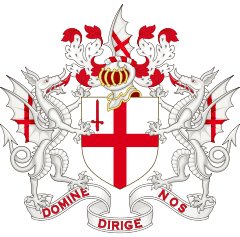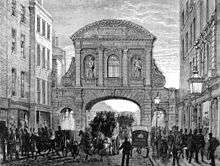Aldersgate
Aldersgate was one of the northern gates in the London Wall which once enclosed the City.
| Ward of Aldersgate | |
|---|---|
 Ward of Aldersgate Location within Greater London | |
| Population | 1,465 (2011 Census Ward)[1] |
| OS grid reference | TQ321817 |
| Sui generis | |
| Administrative area | Greater London |
| Region | |
| Country | England |
| Sovereign state | United Kingdom |
| Post town | LONDON |
| Postcode district | EC1, EC2 |
| Dialling code | 020 |
| Police | City of London |
| Fire | London |
| Ambulance | London |
| UK Parliament | |
| London Assembly | |
It gave its name to the City Ward of Aldersgate, traditionally divided into Aldersgate Within and Aldersgate Without, the suffix denoting whether the part was within the line of the wall or outside it. In 2013 the ancient ward boundaries were redrawn, the names are preserved but their location only loosely approximates to their historic extent.
The gate also gave its name to Aldersgate Street, which runs north from the former gate towards Clerkenwell. The street was wholly part of Aldersgate Without until a short section further north was renamed and so added to it.
The Gate
The Wall was first built around the year 200, but Aldersgate was not one or the original Roman gates, being added later in the Roman period.
The name Aldersgate is first recorded around 1000 in the form Ealdredesgate, i.e. "gate associated with a man named Ealdrād", the gate probably acquired its name in the late Saxon period.[2]
When James VI of Scotland came to England to take the crowns of both England and Scotland he entered the City at Aldersgate. Statues of the King were placed both outside (on horseback) and inside (seated on the throne) the gate to commemorate the occasion.
The old gate was taken down in 1617, and rebuilt in the same year from a design by Gerard Christmas. The gate was damaged in the Great Fire of London in 1666 but was repaired and remained until 1761. Aldersgate Street contained the Bishop of London's chapel and his chambers at London House, which was used from the 18th century because it was closer to St. Paul's Cathedral than his official residence in Fulham.
Ward of Aldersgate
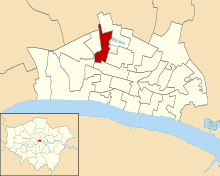

The ward of Aldersgate straddles the (now former) line of London Wall and the old gate and historically was divided into "Within" and "Without" divisions, with a Deputy (Alderman) appointed for each division.
Geography
Aldersgate Within
The Within division was focussed on the buildings on each side of St. Martin's Le Grand (which extends northward as Aldersgate Street), Noble Street and Foster Lane.
The ward took in the liberty of St. Martin's Le Grand when that was dis-established in the 16th century.[3]
Aldersgate Without
The Without division was coterminous with that part of the Ancient Parish of St Botolps Without Bishopsgate that was part of the City. The area included the parish church of St Botolph's Aldersgate and the adjacent Postman's Park, named after the former principal sorting office in King Edward Street, and the location of the Memorial to Heroic Self Sacrifice.
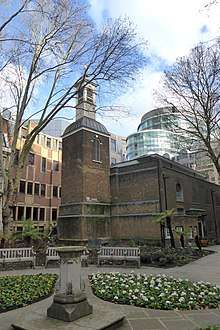
The division was mainly focussed on the buildings on each side of Aldersgate street and included the western part of the Barbican Estate (including the Museum of London), two Livery Company halls (the Ironmongers' Hall and the Plaisterers' Hall) as well as 200 Aldersgate, a large office complex at the southern end of the street.
Post-2013 Ward
Since ward boundary changes in 2013, almost all of the ward is Without and the former liberty and street of St. Martin's is no longer within the ward's boundaries.
The much altered new ward of Aldersgate is bounded by Aldersgate Street, Beech Street, Noble Street, Angel Street, King Edward Street and Montague Street.[4]
Aldersgate Street
Aldersgate Street forms a short section of the A1 route towards Edinburgh. It is located on the west side of the Barbican Estate and Barbican Centre, near St Bartholomew's Hospital and the Museum of London (which falls within the ward).
Northbound it continues into Goswell Road at the junction with Fann Street; southbound it continues into St. Martin's Le Grand. Barbican Underground station is located on Aldersgate Street and when it was opened in 1865 was named Aldersgate Street tube station. In 1910 it was renamed Aldersgate, then Aldersgate & Barbican in 1924, before finally being renamed Barbican in 1968.[5]
Originally Aldersgate Street only corresponded to the section starting from the church of St Botolph without Aldersgate towards Long Lane. The portion of the road from Long Lane till Goswell Street (after 1864 Goswell Road) was formerly named Pickax Street, where today is located the Barbican tube station. This name may derive from Pickt Hatch, an area of brothels said to be in this part of London during the Elizabethan era. Pick Hatch is mentioned in The Merry Wives of Windsor ("Goe … to your Mannor of Pickt-hatch") and in The Alchemist ("The decay'd Vestalls of Pickt-hatch"). By the late eighteenth century the name Pickax was no more in use, and the road was fully incorporated into Aldersgate Street.
Politics
Aldersgate is one of 25 wards of the City of London, each electing an alderman to the Court of Aldermen and commoners (the City equivalent of a councillor) to the Court of Common Council of the City of London Corporation. Only electors who are Freemen of the City of London are eligible to stand.
In the 2017 City-wide Common Council elections, the Labour Party won one seat in Aldersgate ward with local resident Richard Crossan standing for Labour and being elected unopposed.[6] The Labour Party won a record total of five seats on the Common Council in March 2017 winning two seats in Portsoken, two seats in Cripplegate ward and one seat in Aldersgate ward.[7]
Current elected representatives in Aldersgate are Randall Anderson, Nicholas Anstee (Alderman), Adrian Bastow, Richard Crossan, Jeremy Mayhew, Joyce Nash and Barbara Newman.[8]
History
The ward initially only included land within the walls, but a degree of growth beyond the gate meant some of the land beyond came under the sway of the City. Boundary markers - Bars - were established here and elsewhere with the suburb eventually becoming part of the City. Aldersgate Bars are recorded as early as 1197.[9]
A mansion above Aldersgate, referred to as Aldrichgate, was gifted to John Blytone, the earliest known sword-bearer of the City of London when he resigned from the service of the Lord Mayor of London in 1395.[10][11]
Religion
In 1554 Aldersgate Street was the scene of a fraud where Elizabeth Crofts was smuggled into a wall to pretend to be a heavenly voice. Reputedly 17,000 people came to listen to her give out anti-catholic propaganda.[12]
The house of Sarah Sawyer, in Rose and Rainbow Court (approximately the site of the present Museum of London), formed one of the earliest Quaker meetings in London (before 1655). In 1675, it became a dedicated meeting house, the Box Meeting, used mainly by Quaker women for poor relief, on her marriage.[13]
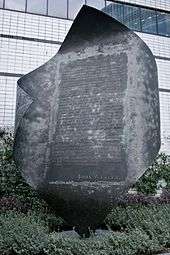
28 Aldersgate Street is the approximate former location of a Moravian Church. On 24 May 1738, attending a meeting at the church, the clergyman John Wesley underwent a profound religious experience. The following year, he broke with the Moravians and founded the Methodist Society of England.[14] The yearly anniversary of his experience is celebrated by Methodists as Aldersgate Day. Wesley's Chapel, in nearby City Road, remains a major focal point of the worldwide Methodist movement.
The arts
The poet Thomas Flatman was born in a house in Aldersgate Street in 1633. As with most historic buildings on this stretch of road, the building no longer stands. At Nos. 35-38 stood Shaftesbury House, built around 1644 by Inigo Jones. It was demolished in 1882.[15] Lauderdale House was demolished in 1708, the London home of the Duke of Lauderdale and earlier the house of his mother-in-law, the Countess of Home.[16]

No. 134 for many years had a sign claiming: "This was Shakespeare's House".[17] Although the building was very close to the nearby Fortune Playhouse, there is no documentary evidence surviving to indicate that Shakespeare resided here; a subsidy roll from 1598 shows a "William Shakespeare" as owner of the property, but there is nothing to indicate that it is the playwright. The building no longer exists, and Barbican station now occupies the site. The nearby Shakespeare Tower is named for this (tenuous) connection. At the point where Aldersgate Street changes its name to Goswell Road there is also a public house "The Shakespeare".
Lost buildings
.jpg)
Adjacent to the modern roundabout on the site of the gate was the former headquarters of the General Post Office (closed in 1910 and demolished shortly afterwards), and the adjoining Postman's Park. The southern part of the roundabout and the northern part of where the Post Office once stood are located on the site of a collegiate church and sanctuary founded in 750 by Withu, King of Kent, hugely expanded in 1056 by Ingebrian, Earl of Essex, and issued with a royal charter in 1068 by William the Conqueror. The site of the church was cleared in 1818 in preparation for the construction of the Post Office.[18]
Most of the buildings on Aldersgate Street were destroyed or badly damaged in the Second World War. The entire length of the eastern side of the street is now occupied by a part of the 40-acre (16 ha) Barbican residential and arts complex.[19]
At the corner in between Aldersgate Street and Long Lane,[20] opposite to the now Barbican station and Beech Street, stood the "Manchester Hotel" with over 240 room. It used to be a Victorian landmark in the area, popular with business men, visitors and juries attending trials at the Old Bailey. Opened in 1879, refurbished and modernised in 1921, suffered severe damages by the Second World War bombs and was consequently demolished. After the First World War it was temporary closed, and commanded by the government as a hostel for Jewish refugees escaping Poland and Belgium.[21] Advertisement of the hotel regularly featured on local magazines and periodicals referring to its splendid rooms, wine cellar, luncheon for City workers, and as a venue for wedding receptions.[22]
See also
Image gallery
 Site of Aldersgate
Site of Aldersgate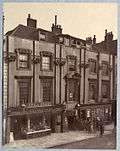 ShaftesburyHouse - demolished in 1882
ShaftesburyHouse - demolished in 1882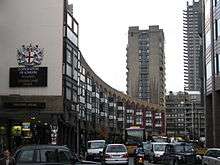 Aldersgate Street
Aldersgate Street Aldersgate Street, north side from the Barbican highwalk
Aldersgate Street, north side from the Barbican highwalk Aldersgate Street, south side from the Barbican highwalk
Aldersgate Street, south side from the Barbican highwalk- Little Britain, a street in the ward
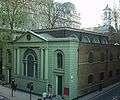 St Botolph-without-Aldersgate Church
St Botolph-without-Aldersgate Church St Botolph-without-Aldersgate Church after redecoration
St Botolph-without-Aldersgate Church after redecoration- Postman's Park from Aldersgate Street
 Aldersgate plaque
Aldersgate plaque Aldersgate history
Aldersgate history Aldersgate street view
Aldersgate street view
References
- "City of London Ward population 2011". Neighbourhood Statistics. Office for National Statistics. Retrieved 16 October 2016.
- Mills, A.D. (2010). A Dictionary of London Place-Names. Oxford University Press. p. 4. ISBN 9780199566785.
- A Topographical Dictionary of England, Samuel Lewis, 1831, p 134
- Map of reformed ward of Aldersgate http://democracy.cityoflondon.gov.uk/documents/s63801/Aldersgate.pdf
- Williams, Hywel (2004). "Renamed Stations". London Underground History. Retrieved 10 May 2007.
- In the 2017 City-wide Common Council elections, the Labour Party won one seat in Aldersgate ward with local resident Richard Crossan standing for Labour and being elected unopposed
- The Labour Party won a record total of five seats on the Common Council in March 2017 winning two seats in Portsoken, two seats in Cripplegate ward and one seat in Aldersgate ward
- Find Member - Results by ward: Aldersgate
- London, its origin and early development William Page 1923 (including reference to the primary source). Link: https://archive.org/details/londonitsorigine00pageuoft/page/178/mode/2up/search/bishopsgate p179
- Barrett, Edward (2017). Ceremonial Swords of Britain: State and Civic Swords. The History Press. p. 119. ISBN 978-0-7509-6244-5.
- Carpenter, John; Whittington, Richard (1862) [1419]. Liber Albus: The White Book of the City of London. Translated by Riley, Henry Thomas. John Russell Smith. p. 479. Retrieved 2 February 2018.
- Daniel Hahn, 'Crofts, Elizabeth (b. c.1535)’, Oxford Dictionary of National Biography, Oxford University Press, 2004 accessed 7 Dec 2014
- Quakers Around Shoreditch (Andrew Roberts, ed.) Archived 6 October 2006 at the Wayback Machine accessed 10 October 2006
- "What is Aldersgate Day?". umc.org. The United Methodist Church. Retrieved 22 May 2016.
- "Aldersgate". British History Online. Retrieved 10 April 2012.
- Peter Cunningham, A Handbook for London, vol. 2 (London, 1849), p. 471.
- Winter, William (1910). Seeing Europe with Famous Authors: Literary Shrines of London. London: Moffat, Yard & Co. Archived from the original on 28 April 2015. Retrieved 7 October 2011.
- "Aldersgate Street and St Martin-le-Grand". Old and New London. Centre for Metropolitan History. 2: 208–228. 1878. Retrieved 10 May 2007.
- "History of the Barbican Estate". City of London Corporation. Archived from the original on 15 March 2007. Retrieved 10 May 2007.
- https://www.british-history.ac.uk/st-barts-records/vol2/pp159-180
- https://www.eastlondonhistory.co.uk/manchester-hotel-aldersgate-street-ww2-photos/
- https://elwyjones.wordpress.com/2014/10/02/the-manchester-aldersgate-london/
External links
| Wikimedia Commons has media related to Ward of Aldersgate. |
- City of London Corporation Map of Aldersgate ward (2003 —)
- 1772 map of Aldersgate ward showing its precincts
- Historic map showing the ward of Aldersgate, its two divisions and the liberty of St Martins
- 18th century map showing the location of the gate (towards the bottom right corner)
- Map of Early Modern London: Aldersgate Ward - Historical Map and Encyclopedia of Shakespeare's London (Scholarly)
- Aldersgate Ward Club - A Social Club based in the City of London
